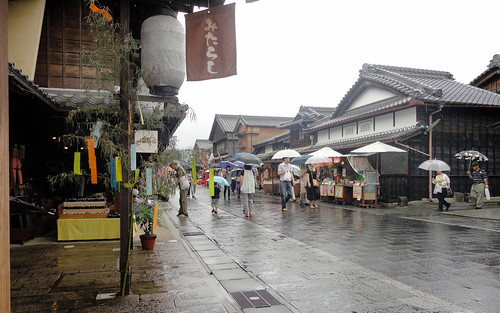Taking a trip to Okage Yokocho (おかげ横丁|おかげよこちょう) is sometimes like stepping back in time to an Edo Period village. Okage Yokocho, is a shady side street of Oharaimachi just before you reach Naiku, the inner shrine of the Grand Shrines of Ise. In recent times it has experienced a bit of a revival. The narrow streets and restaurants are usually very crowded at new years when many people make a visit.

Mitarashi Dango
We went in the middle of a Summer downpour on a Saturday and it was still hard to find a car park. The streets look empty here, but under every eave and doorway there were crowds of people waiting for the next break in the rain so they could make it to the next stall or performance. The store here was our second stop for Mitarashi Dango, you can see the sign just above the Tanabata decorations.
Japanese Drums
 The Japanese Drum (和太鼓|わだいこ) performance happens once every hour, and it always draws a big crowd. Somewhere amongst the forest of umbrellas is furious example of traditional drumming. The musicians have arms as think as tree trunks and deep burning gaze. I should have been much closer. It was enough though to stand back and enjoy the energy and enthusiasm of the performance.
The Japanese Drum (和太鼓|わだいこ) performance happens once every hour, and it always draws a big crowd. Somewhere amongst the forest of umbrellas is furious example of traditional drumming. The musicians have arms as think as tree trunks and deep burning gaze. I should have been much closer. It was enough though to stand back and enjoy the energy and enthusiasm of the performance.Paper Play
As the large crowd dispersed there was a small gathering forming closer to the back of the main stage. There was a paper play (紙芝居|かみしばい) just about to begin so we took our seats. The performer, in yukata and geta, told the story of Shiro-kou, a dog from the Gunma prefecture.
In Edo period Japan it was quite popular for people from all over the country to make a the pilgrimage to Ise, and in the space of as little as 50 days over 3 and a half million people would arrive. Most of them on foot. Those that couldn't make it due to illness or injury would send some one in their stead to retrieve charms, some times they would send their dogs. Shiro-kou was one such dog.
The style of story telling reminded me of Rikimaru Toho, the manga reading busker from Tokyo whom I've written about before. What I didn't realise was how Rikimaru was simplying bringing a modern touch to a traditional form of entertainment.
In this new media era of television, internet and games, the paper play seems a rather archaic and simple form of entertainment. Compared with books, the history of kami shibai is still rather shallow, but story telling goes much deeper. The oral tradition is so important to the maintenance of culture. It's not just simple entertainment, but more importantly it conveys Japanese culture in a way that I'd like to see continue. You can see some of the performance in this video.
Okage Yokocho In The Summer Rain
When you speak a second language you become part of a new socio-cultural group. What I've noticed about people who can tell a good story is that they tend to accelerate in their ability to speak Japanese. Do you have any good stories that you could tell in Japanese? You don't have to tell me right now, but when you speak Japanese you should have a story ready to go ;) I'll be here in Japan until Monday, and I'm looking forward to getting back into a routine with my blogging. I'll plan on bringing you more of my trip in future posts, including that crazy little fish shop at the end of the video. Until then Jyaa mata ne! P.S. If you like a little bit of story telling you should pick up my newsletter, you'll also get a great free guide to manga. P.P.S. If you like to keep you story telling short follow me on Twitter @rainbowhill.